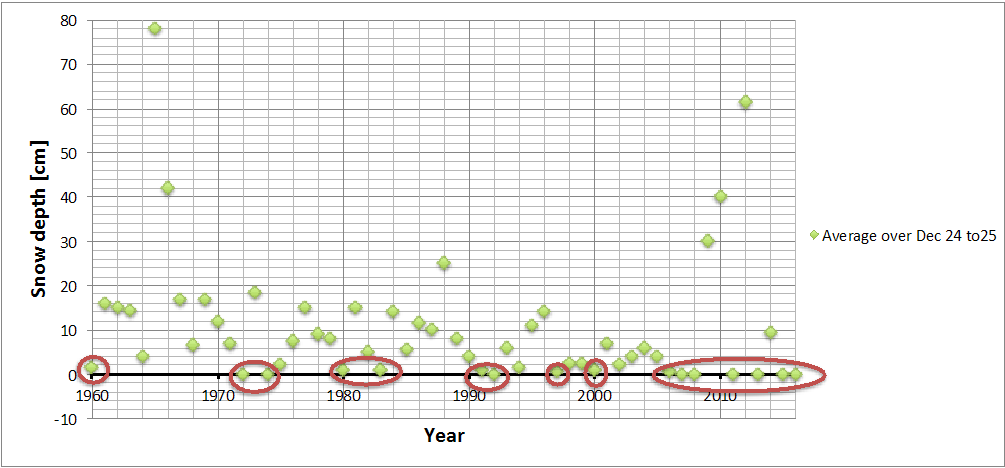Nearly every Christmas, I travel back to Finland in the hope of celebrating Christmas Eve in the well below freezing temperatures surrounded by a plethora of snow. My childhood memory of this magical day begins with a cross-country skiing trip in the forest amongst frozen sparkling trees, with low mid-day sun gently thawing the icicles formed on eyelashes by my sublimed breath. The skiing trip is followed by a heart and bone warming sauna and a plunge into a soft snowdrift to even out the body temperature. However, over the past decade this nostalgic childhood memory of a white Christmas has begun to fade and be replaced by a new one where a skiing trip is now a mere walk in the rain and the snowdrift a mud puddle. Is this childhood memory real? I decided to investigate.
Figure 1 shows snow depth at Helsinki-Vantaa airport weather station, averaged over Christmas Eve and Christmas day from 1960 onwards. Having lived in and around the capital area, this weather station is chosen to refresh/test my memory. Other weather stations in and around Helsinki show similar measurements. The snowless Christmases are circled. To be consistent with the Finnish Meteorological Institute (FMI) definition, “snowless” is defined as snow depth below 1 cm. It is clear that out of the 16 snowless Christmases shown, 50% have occurred since the turn of the millennium and following the first 15 years of my life. Before 2000, I only lived through three snowless Christmases. Since moving out of Helsinki in 2005, a snowless Christmas appears to be more of a norm than an anomaly. In particular, the 21st century snowless Christmases have mostly been wet and warm as seen in Figure 2. Given the data, I hence preserve the right to claim that my childhood was filled with white Christmases.

Figure 1. Snow depth (cm) at Helsinki-Vantaa airport weather station, averaged over 24-25 December. Snowless Christmases are circled. “Snowless” is defined as having snow depth below 1 cm. Weather station data is available from Finnish Meteorological Institute (FMI) and also at http://suja.kapsi.fi/fmi-suomi.php.


Figure 2. (upper) Daily accumulated precipitation (mm) and (lower) Mean daily temperature (°C) at Helsinki-Vantaa airport weather station, on 24 December. Snowless Christmases are circled.
Does the lack of snow at Christmas in Helsinki reflect the lack of precipitation or is it just a harsh reality of a warming climate? Figure 3 shows the temperature and precipitation anomalies for December of all the years with snowless Christmas. Indeed, it appears that the snowless Christmases are mainly due to anomalously warm December temperatures.

 Figure 3. December anomalies (from 1959-2015 mean for the Helsinki-Vantaa airport weather station) of (upper) Precipitation (%) and (lower) mean daily temperature (°C]. Only years with snowless Christmases are shown.
Figure 3. December anomalies (from 1959-2015 mean for the Helsinki-Vantaa airport weather station) of (upper) Precipitation (%) and (lower) mean daily temperature (°C]. Only years with snowless Christmases are shown.
This trend for snowless Christmases in Helsinki is, of course, likely a manifestation of internal variability. However, I am seriously contemplating celebrating Christmas a month later. Since 1960, the average daily January temperatures have been below freezing and even the smallest amount of January total precipitation of 8.1 mm (in 1972) would produce at least 8 cm of snow cover* – enough to recreate that childhood memory of a white Christmas!
